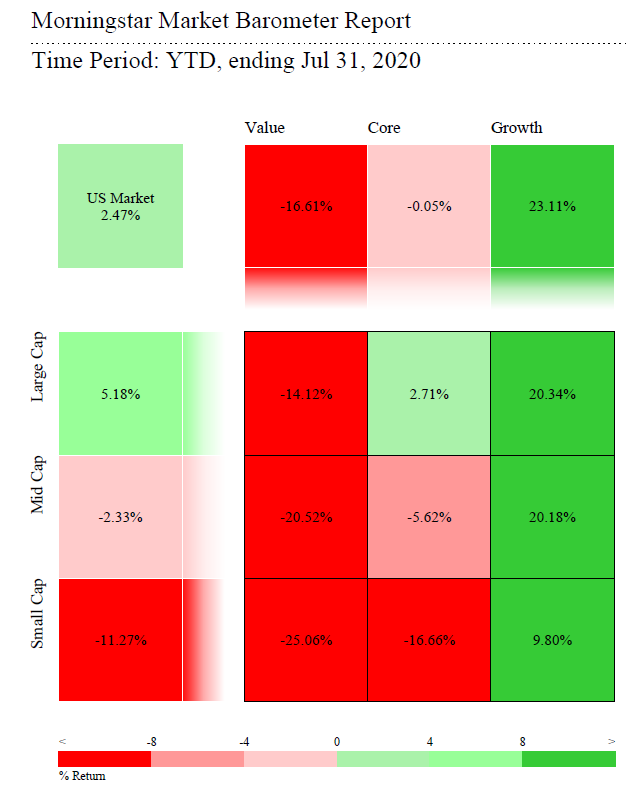Knightbridge Capital Mid-Year Review & Outlook
Market Overview: Fed provides the backstop and markets take off - but have they rallied too far?
Significant monetary policy action by the Federal Reserve on the heels of a broad economic slowdown attributable to COVID-19 coupled with a major fiscal policy response through the passing of the CARES Act by Congress and signed into law by the President put a floor under asset prices in late March and created an environment for significant price reflation thereafter. Across the globe, investors breathed a collective sigh of relief as a coordinated central banking effort was able to provide enough support allowing for markets to function properly and create an environment where asset prices could begin to rebound. Whether markets can continue to rally given the significant move higher in recent months remains to be seen.
While the broader macroeconomy seemed to have bottomed back in April when much of the country was in some form of stay-at-home order/lockdown, financial markets continue to price in either an all-out “V-shaped” recovery or a strong “U-shaped” recovery given recent levels. And this is where we believe caution is warranted! The rally back has been extraordinary and has most investors feeling good about the overall environment, but the financial markets are quite different from the underlying economy. There has been significant structural damage inflicted on the economy that may take a vaccine or more to fully return to normal which may take much longer than markets anticipate. Looking to the latter part of this year, we see back and forth markets driving elevated volatility as the prevailing low interest rate environment combined with a still relative underweighting to global equities offsets a riff within Congress over support for workers displaced by the pandemic, elevated geopolitical uncertainty – especially with respect to China and the continuing hostile political environment ahead of the November election.
Our predisposition is to maintain a neutral stance with respect to macro equity and fixed income allocations given the accommodative environment in place which is likely to keep a cap on interest rates for some time. That said, our fixed income viewpoint is slightly more cautious as opportunities remain limited within the current backdrop. As always, we believe a properly risk-allocated portfolio is one that is well-diversified across asset classes and mindful of the risk inherent in these underlying assets. Within equities, the growth over value paradigm seems to be getting aged and we look for a meaningful reversal to occur at some point while understanding a return to parity may take time. As a result, we continue to manage core portfolio strategies attempting to uncover and hold positions that should perform in varied market climates where these companies are well positioned within their respective industries, exhibit pricing power and have strong balance sheets with disciplined capital allocation strategies.
Long-term investors should consider how the policy landscape will likely look after the election and the pandemic. Fiscal policy is likely to be very expansionary under either party, as there now appear to be no fiscal hawks among either the Democrats or the Republicans. Moreover, as the pandemic ends, pent-up demand for services should generate very strong economic growth, potentially absorbing economic slack much faster than in previous expansions. While this would be positive for the stock market it could also push inflation well above 2% in 2022.
- Dr. David Kelly, Chief Global Strategist JP Morgan Asset Management1
Equity Markets
After Q1’s significant challenges driven by the unknowns surrounding the COVID-19 outbreak and the volatility it created, Q2 improved as this “unknown” that was trending towards “uncertainty” became less of a market obstacle as the Federal Reserve announced a significant amount of accommodation through various asset purchasing programs and the Administration and Congress providing approximately $2.3 trillion in broad economic support through the passing of the CARES Act. This coupled with the negative impact from COVID-19 expected to crest sometime between mid-April and early-May set the table for an outsized rally as certain elements of the stimulus began to take hold. However, very few market observers anticipated the magnitude of the rebound that brought equity indices either near to or at January levels. The question now is, have equity markets rallied too far given the meaningful headwinds that still remain or are markets poised to continue higher as the economy reopens and life moves to a new normal? While a decade-plus bull market ended during the first quarter, the combination of unprecedented monetary and fiscal support along with a shift in valuations may be setting equity markets up for a run to new highs in the coming months and years.
During the first half of the year domestic equities experienced trends similar to those seen in 2019 with growth far outdistancing value from a style perspective, to levels rarely seen as the separation between styles stretched to its widest since the March 9th 2009 lows during the Great Financial Crisis. A similar trend has occurred with respect to capitalization as large cap stocks outpaced both mid and small cap stocks during the first half of the year, though in the middle of the second quarter this began to reverse and is something to watch closely during the second half of 2020. From a sector perspective, leading sectors during the first half included technology and consumer discretionary which both posted positive absolute performance along with communication services and health care which were close to unchanged while lagging sectors included energy, financials, industrials, utilities, real estate, materials and consumer staples. Technology benefits significantly from the COVID-19 work-from-home trend which surpassed hopes for a vaccine coming to fruition, a trend that likely continues as companies look to become more agile and productive in the coming years. Energy, felt the “perfect storm” of building supply heading into COVID-19, lessening demand throughout the pandemic and a significant amount of countries and companies needing to produce at unfavorable economics which negatively impacted the sector during the first half of the year but also may be telling of future prospects given the “new normal” that likely takes hold post the pandemic.

Exhibit 1
Similar to domestic equities, international equities experienced a traumatic Q1 only to rebound significantly in Q2. During the first half, emerging markets outperformed developed markets with much of this driven in the month of June as a risk-on trade was fully embraced late in the quarter with Asia outperforming Europe and Latin America. Moving forward, we see emerging markets as slightly more favorable with respect to valuation but also somewhat uncertain and likely needing an improved macro environment and more of the recent risk-on environment for the potential outperformance to come to fruition.
As we look ahead to the back half of 2020, we believe that risks are amplified with respect to elevated valuations on top of a continued volatile macro backdrop. Containing the COVID-19 pandemic and returning at least partially back to normal will be necessary to drive equities higher. While we believe that both monetary and fiscal policy will remain supportive in aiding and reclaiming the lost economic activity, the ability of these actions to do so without positive macroeconomic momentum will be limited and does present a significant back half risk to broader equities. We are keenly focused on earnings commentary regarding corporate management tone pertaining to revenue growth, the ability to produce meaningful earnings given a lower revenue base and the willingness to spend on capital investments which is necessary to protecting market share during times of economic dislocation. Quality stock selection should become of greater importance and is likely to be rewarded going forward. From an allocation perspective we continue to remain neutral towards equities pairing accommodative monetary and fiscal policy with elevated valuation coupled with rebounding macroeconomic growth and potential political pitfalls building as we move closer to the 2020 U.S. Presidential election. We see opportunity in emerging market equities (relative valuation and a weaker U.S. dollar), value stocks (style rotation opportunity) and more specifically large cap financials (money center banks such as JP Morgan (JPM); and diversified financial services companies such as Goldman Sachs (GS)) benefiting from scale and continued capital flexibility.
Fixed Income
Debt markets rallied back from March lows to post a strong second quarter as significant policy action from the Fed and optimism around a robust economic recovery benefited performance across most of the asset class. The aggregate bond category ended the second quarter +6% year-to-date in total return benefiting from the continued low interest rate environment and unprecedented central bank monetary accommodation. As expected, economically sensitive categories performed best with convertible bond, high yield, emerging market and leveraged loan areas leading the way. Convertible bond performance was the standout, returning approximately 30% on average during Q2 benefiting from the strong rise in equities and lower rates. Conversely, after strong Q1 performance driven by a flight to safety, treasury securities lagged and look extraordinarily challenging moving forward from a risk/return perspective as we are likely in a “lower for longer” interest rate environment for the foreseeable future. Our view is that the broader Treasury complex seems priced for perfection and too risky at current levels. On the municipal front, performance while positive was muted as investors attempted to digest the broader damage done to revenue bases from the mandated lock downs and quarantines across much of the country as well as the headwinds to parts of the economy (i.e.. tourism) for a full recovery absent a vaccine. The potential surge in the supply of municipal offerings as cities and states look to close revenue gaps will press investors to be more critical in assessment municipal credits and where to deploy capital.
As we move into the latter part of the year, expectations are muted given the solid returns year-to-date and the likelihood of less deviation in rates given the Federal Reserve Board’s supportive bias. A recovering economy coupled with accommodative global central banks and manageable inflation (at least for now) point to a mixed outlook for the broader asset classes with returns likely below historic levels. Collectively our predisposition on the margin is toward modestly higher exposure to high yield and senior loan categories married with exposure to treasury inflation protected securities and low duration fixed income.

Exhibit 2

Exhibit 3

Exhibit 4
KbC Equity and Allocation Strategy Model Portfolios
KbC equity strategies performed admirably during the first half of 2020 as all but one strategy outperformed against its respective benchmark. While equity markets were volatile driving challenging absolute performance, the relative performance of our strategies proved their mettle. We spoke to volatility likely presenting itself in some form in 2020 (full disclosure – we have been writing about it since our year-end 2017 installment), but what we saw in March was volatility in the extreme as almost all asset classes were impacted, not just equities and commodities. Stock selection proved to be paramount yet again, in outperforming versus respective benchmarks as our “core” portfolios benefited from positions that tilt growth as well as value-oriented positions that performed equally well on a relative basis. Moreover, staying invested and not raising cash allocations served the portfolios well.
Our best performing strategies were those that tilt modestly towards growth such as Alpha Leaders and Mid Cap, as this style overwhelmed value during the first half of the year. Dividend strategies outperformed benefiting from the continued low interest rate environment as the gap between the average holding’s dividend yield and the 10-year U.S. Treasury yield further widened. Market strategies provided modest outperformance during the first half aided by strong stock selection in its technology, healthcare and consumer holdings. Finally, our Strategic Asset Allocation strategies experienced solid returns benefiting from its nearly fully invested exposure and an opportunistic approach to capture trading alpha taken during the extremely volatile period in mid- to late-March. Alpha Tax/Qualified lagged during the front half of the year with the equal weighting approach tilting the strategy toward value positions and softening performance. As we continue to expect elevated levels of volatility (though likely not at March levels), we feel the risk-/reward tradeoff of equal weighting and the tax sensitivity of the strategy positions it well in the forward.
The information provided herein is the opinion of Knightbridge Capital and subject to change without notice. It is not to be construed as investment, legal or tax advice. This publication may contain forward looking statements which reflect our best judgment based on factors currently known but involves significant risks and uncertainties. Actual results will differ from those anticipated in forward looking statements as the result of changes in underlying assumptions including, but not limited to systemic, macro and company-specific risks.
Knightbridge Capital is an investment management option available through Prentice Wealth Management, LLC, an SEC Registered Investment Adviser. Securities offered through Cadaret, Grant & Co. Inc. member FINRA/SIPC. Advisory services offered through Prentice Wealth Management, LLC. Prentice Wealth Management and Cadaret, Grant & Co. Inc. are separate entities.
1. https://am.jpmorgan.com/us/en/asset-management/gim/adv/insights/week-ahead
Exhibit 1, 2, 3: Data source Morningstar Office.
Exhibit 4: Morningstar Market Barometer provides a visualization of the performance of Morningstar Indexes. ©2020 Morningstar .







